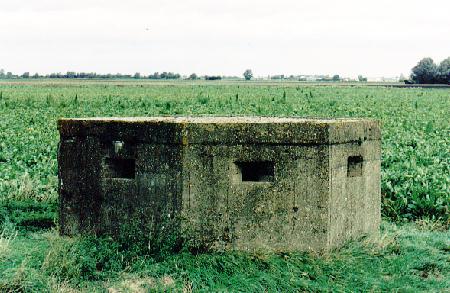|
Pillboxes
On Armistice Day each year, we remember those who gave their lives for their country but often forget to thank our good fortune for the freedoms we now enjoy. As the years pass, those who lived through the two world wars become fewer and soon these conflicts will be relegated to the pages of history and yet there was hardly a single family that was not touched in some way by these wars to end all wars as each was hailed at the time.
The threat to our daily life was equally real while the men folk were away fighting and although most people's perception of what it was like on the home front during the early years of the Second World War is now governed entirely by glimpses of
Dad's Army on television, anyone who lived during that time can attest to the hardships suffered and the fears endured and during the early years of the war we lived daily with the threat of invasion from across the North Sea. This part of England was particularly vulnerable because of the wide expanse of Lincolnshire coastline and rumours abounded of attempted landings that would one day put this country under enemy rule that was already tyrannising much of Europe.
Pillboxes were the first line of our wartime defence against such an invasion. More than 20,000 were built and although most have been demolished since the war ended, some 10 per cent have survived, mainly in isolated rural areas, usually alongside country roads, where the Home Guard or regular army units could mount machine gun attacks against the oncoming invaders.
When war was declared in September 1939, there were frantic preparations put in place to defend the country. A German invasion was expected at any moment following the fall of France. Winston Churchill summed up the national mood when he said: "We shall defend our island whatever the cost may be. We shall fight on the beaches, we shall fight on the landing grounds, we shall fight in the fields and in the streets, we shall fight in the hills. We shall never surrender."
By the late summer of 1940, as the Battle of Britain raged overhead, the country's defences were growing everywhere, their construction in the hands of a workforce of hundreds of thousands of people. They transformed Britain's landscape into a vast fortress, more extensive than was often realised at the time, to hold and contain invading forces, making use of existing obstacles such as hills, railways and rivers. Vulnerable beaches were hardened with concrete and steel anti-tank devices were installed together with minefields, barbed wire entanglements, flame throwers, infantry and artillery fieldworks and of course pillboxes. Large areas suitable for German aircraft to land were blocked with improvised obstacles such as poles, wires and trenches while the streets of many towns and villages were protected by the construction of fortified settlements known as anti-tank islands at major road intersections.
By 1942, pillboxes and fixed defences were thought to be too immobile and the authorities decided to stop building them. Many in public places were demolished immediately after the war because they were judged to be unsightly but a large number of coastal and rural pillboxes survived, some being used as storerooms by farmers but most simply neglected. The estimated 2,000 that are left are the most easily recognisable relics of the 1940 anti-invasion defences, sturdily made in a variety of designs, although the most popular was the hexagonal structure of pre-cast concrete with gun slits on each side, similar to that pictured above that can be seen today about 12 miles south east of Bourne in a field by the side of B1443 in Borough Fen, between Peakirk and Thorney.
These distinctive concrete fortifications dotted around the English countryside are an important part of our recent history but there is growing concern over their vulnerability and so English Heritage has been carrying out a survey of those that still exist with the intention of giving them statutory protection for the future. To the casual passer-by, they appear to be nothing more than a concrete shelter with no apparent purpose but they have potent associations of a time when Britain stood alone and on the brink of a German invasion which, had it succeeded, would have meant a very different lifestyle from that which we enjoy today.

Go to:
Main Index Villages
Index
|
